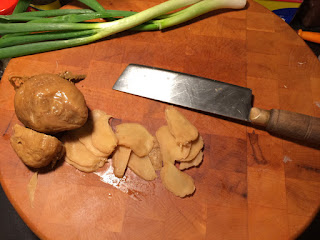Only very recently that the Western press talks about Japanese washoku 和菜 . Washoku 和菜 means Japanese home cooking in a not so good translation. The two Kanji 漢字 words - 和 means in harmony and 菜 means a dish. A similar term in Chinese is 家菜 (pronounced as gar-choy in Cantonese) though the Chinese one has a connotation of being simple and prepared with unassuming ingredients, except for special occasions. The alternate term for is chang-chai 常菜, meaning daily routine home dishes.
The definition of gar-choy 家菜 can be quite problematic as China is so vast. The ingredients or the lack off can vary significantly from cities to rural village, and from rich to poor. A few characteristics that are typically common are cook with the ingredients available locally to make the most out of them. Contrary to the misrepresentation of Chinese cuisines in the West deep fry and greasy dishes are not the norm. Almost always there are plenty of vegetable dishes and often a soup accompanies a typical family meal.
Recently I have been wanting to remake dishes from childhood and young adulthood memory, as well as to explore some regional cuisines that are relatively less familiar to me. Many of these dishes involve the use of Chinese cooking condiment, spices, or preserved ingredients. Some involves the use of preserved meat, vegetable or seafood. The preservation methods range from dehydration, salted, to fermentation.
this meal has my home made char siu 叉燒 - char siu typically is store bought instead of home made
Sichuan peppercorns 花椒 - they are not really peppercorns
Chinese dry roasted peanut - it's quite different the counterpart in the West; this is eaten as a snack
white pepper corns - one whole pound of them
one of many varieties of salt preserved turnips; it was supposed to be 榨菜 but I could not tell for sure due to the packaging
one of many variations of dried tiny fish
a salt-preserved root vegetable from Tianjin called do-choy 冬菜
one of many varieties of bean curd - this one is red mainly for cooking as opposed to eaten directly in a mean
here I am making minced pork the old fashion way - this method is so much easier than bothering with a food processor especially when I only want to make a very small quantity
I wanted to make a steamed minced port with zha chai 榨菜 but I think these are a different kind of salted root vegetable like the big head vegetable 大頭菜
In this meal I made two dishes. One is steamed mince pork with zha chai 榨菜. The other is a fermented black beans and garlic braised little dried fish. The little dried fish is relatively hard to find here in USA, unless you live in large cities with big Chinese population. Even then the high quality ones are extremely hard to find. The ones I use are white and are not the dried anchovies that are often seen in Japanese and Korean cuisines.
To Westerners both these dishes are relative salty. There is a reason behind their saltiness. They are meant to be eaten with a bowl of plain rice. Typically one consume quite a bit of rice but very small amount of these two dishes. Hence is a meal with relatively few calories. I added some dried chilli peppers to both dish to add some heat. I also used some Sichuan pepper corn on the steamed pork dish. Both these dishes are quite savory, especially the braised little fish. One challenge of the braised fish dish is to not overcook or undercook them. There is a very fine balance so that the fish are a bit chewy. The worst is to overcook them or soak them too long resulting in a mushy texture.
dried little fish braise in soy sauce (left), and steamed mince pork with zha chai 榨菜













No comments:
Post a Comment